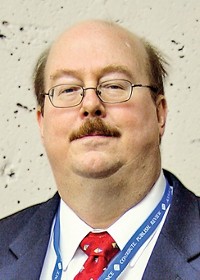Advertisement
Grab your lab coat. Let's get started
Welcome!
Welcome!
Create an account below to get 6 C&EN articles per month, receive newsletters and more - all free.
It seems this is your first time logging in online. Please enter the following information to continue.
As an ACS member you automatically get access to this site. All we need is few more details to create your reading experience.
Not you? Sign in with a different account.
Not you? Sign in with a different account.
ERROR 1
ERROR 1
ERROR 2
ERROR 2
ERROR 2
ERROR 2
ERROR 2
Password and Confirm password must match.
If you have an ACS member number, please enter it here so we can link this account to your membership. (optional)
ERROR 2
ACS values your privacy. By submitting your information, you are gaining access to C&EN and subscribing to our weekly newsletter. We use the information you provide to make your reading experience better, and we will never sell your data to third party members.
Policy
Employment Benefits: Changes And Challenges
by H. N. Cheng and Martin L. Gorbaty, 2006 and 2007 Chairs, respectively, Committee on Economic & Professional Affairs
March 12, 2007
| A version of this story appeared in
Volume 85, Issue 11
At the San Francisco national meeting, the Committee on Economic & Professional Affairs (CEPA) Subcommittee on Public Policy held a round-table discussion on workforce-related public policy issues. More than 70 people attended, including many American Chemical Society leaders and members with different backgrounds, ages, and ethnicities. Consultant Jon Hochman capably moderated the discussion, which focused on several public policy questions.
The responses of individual participants were collected and compiled. When participants were asked what the number one workforce issue was, the most prevalent answer was "employment benefits." When they were asked what the government should do, the two most popular answers were "provide a national health plan" and "provide some form of pension protection."
The strong response concerning employment benefits was unexpected but not surprising. We have occasionally heard about changes in health or pension plans in some organizations. Perhaps recent demographic and employment trends may also contribute to the concern. According to the 2006 ACS member survey, the average age for ACS members is 47; thus, an area of interest may be retirement security. Furthermore, an increasing number of ACS members work either in small companies that may offer more limited employment benefits or as consultants and independent contractors.
In 2005, the CEPA Subcommittee on Surveys included employment benefits as part of the 2006 Comprehensive Salary & Employment Status Survey. The questions on benefits focused on several areas: savings plans, stock options and flexible spending, paid vacations and sick leave, medical and dental plans, life and accident insurance, training and travel to meetings, and employer-defined pensions.
The 2006 survey results give valuable statistics on these benefits (C&EN, Sept. 18, page 42).
An earlier survey on employment benefits was conducted in 1998, and a comparison of the two surveys reveals the changes that occurred the past eight years. The good news is that the percentages of people receiving the benefits have not changed much. Thus, benefits have not been taken away. But there is some dilution of benefits. In medical benefits, there has been a shift of 11 percentage points from "all expenses paid" to "partial expenses paid." In college tuition reimbursement, there has been a shift of nine percentage points from "all expenses paid" to partial or no payment.
Traditionally, the four legs of the U.S. retirement platform are Social Security, employment-based retirement plans, personal savings, and retiree health care. There is cause for concern for some of these legs. According to Bureau of Labor Statistics (BLS) data as of March 2006, only 60% of all U.S. workers have access to retirement benefits, and 51% participate in at least one type of retirement plan.
Most Americans appear not to save enough for retirement. Information from the Retirement Security Project showed that only 49% of American workers have access to a 401k plan, and of that number, only 79% choose to participate. We hope the Pension Protection Act, signed into law in August 2006, will encourage more use of 401k plans.
As for Medicare, it is well-known that the baby boomers will hit the system in 2011, and there will be a corresponding dramatic increase in the number of beneficiaries. A significant cost problem will result unless the government takes appropriate action.
CEPA has been monitoring workforce trends through its surveys, forums, and round-table discussions. To better communicate the results of the benefits survey, CEPA is hosting a symposium at the Chicago national meeting at which several speakers from BLS, industry, and ACS will discuss trends in benefits.
In addition, the Subcommittee on Public Policy has recommended an ACS policy statement on retirement security that addresses the retirement platform. The Board Committee on Public Affairs & Public Relations is reviewing the statement in conjunction with CEPA.
What can an individual ACS member do in view of these changes? If you have more than one job option, you need to compare the benefits packages carefully. If you notice any changes in your employment benefits, you should study the changes and understand their significance. Although personal financial needs differ, it is often advisable to participate in a 401k plan if available. If possible, additional savings are useful, either for investment, for contingencies, or for retirement.
In the legislative area, you can write to your congressional representatives and ask them to take action to strengthen the four legs of retirement security.
If you are interested in learning more about employment benefits, much information is available from several government and private sources, for example, the Bureau of Labor Statistics, the Employee Benefits Security Administration, the Employee Benefit Research Institute, the Urban Institute, and the Retirement Security Project.
Views expressed on this page are those of the author and not necessarily those of ACS.






Join the conversation
Contact the reporter
Submit a Letter to the Editor for publication
Engage with us on Twitter